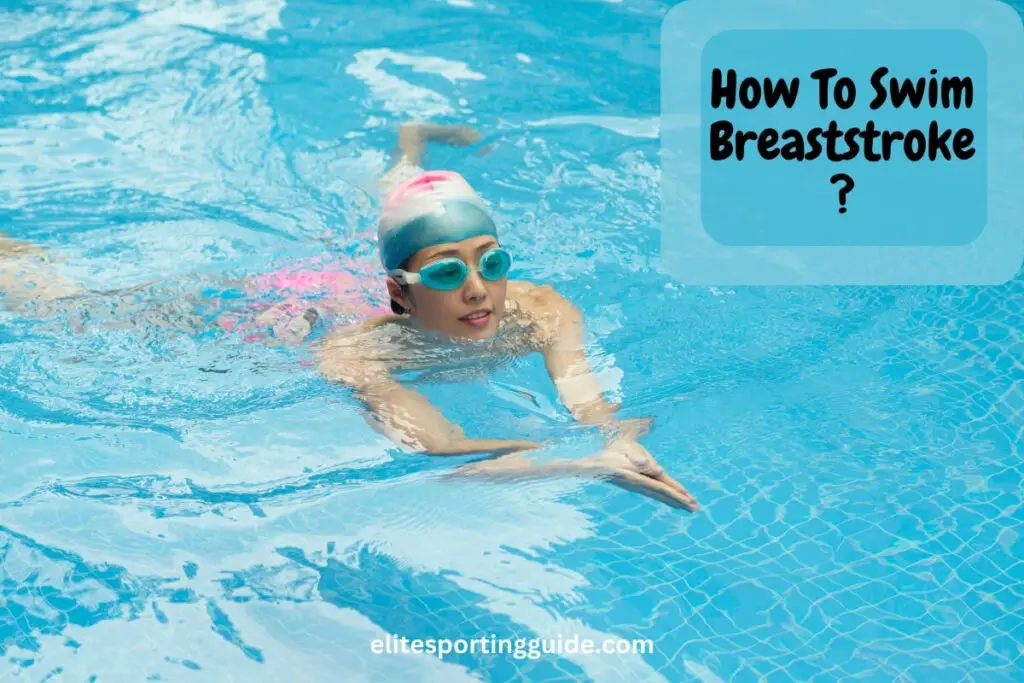In this article, we’ll break down the key components of the breaststroke, from body position and arm movements to the all-important kick.
With step-by-step instructions and valuable tips, you’ll learn how to swim breaststroke with confidence and finesse, making it an essential skill for anyone seeking to enjoy the water to the fullest.
So, get ready to glide through the pool effortlessly as we explore the art of swimming breaststroke.
How To Swim Breaststroke
Swimming breaststroke involves a specific sequence of movements. Start by floating face-down in the water with a streamlined body, then pull your arms in a circular motion, sweeping them outwards and back in towards your chest. Simultaneously, perform a frog-like kick, bringing your heels towards your buttocks and extending your legs outward with a simultaneous glide. Remember to coordinate your arm and leg movements for a smooth and efficient breaststroke, maintaining a steady rhythm as you breathe when your head is above water.
Body Position and Streamlining
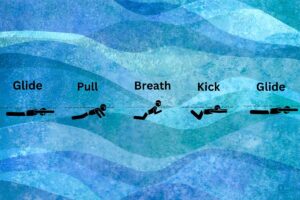
Achieving the correct body position and maintaining streamlined posture is the foundation of mastering the breaststroke.
Begin by floating face-down in the water, keeping your body parallel to the surface. Your head should be submerged while your eyes gaze forward.
Extending your arms straight ahead, create a streamlined shape with your body, minimizing resistance and maximizing forward motion.
This position minimizes drag, allowing you to glide effortlessly through the water.
Maintaining a streamlined body during the breaststroke is essential for conserving energy and improving speed.
As you progress through the stroke, strive to keep your body as horizontal as possible.
Avoid excessive undulation or lifting your head too high during the breath, as this can lead to increased drag and hinder your progress.
By mastering the art of body position and streamlining, you’ll set the stage for an efficient and elegant breaststroke technique, making each stroke more powerful and graceful.
Arm Movements
The arm movements in the breaststroke play a pivotal role in propelling you through the water with precision and power.
The arm technique is divided into two main phases: the pull phase and the recovery phase.
1. Pull Phase: Start with your arms extended forward and your hands shoulder-width apart.
Initiate the pull phase by sweeping your hands outward and around in a circular motion, simultaneously bending your elbows.
Your palms should be turned outward and fingers should point slightly downward.
This motion creates a powerful sweep that propels you forward. As your hands move outward, press your chest and upper body downward, maximizing your forward momentum.
Exhibit A

Exhibit B
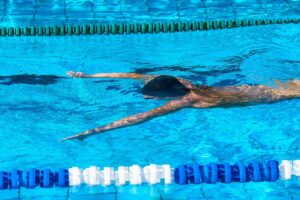
2. Recovery Phase: After completing the pull, your hands should be close to your chest.
Begin the recovery phase by sweeping your arms back toward the streamlined position.
Keep your elbows high, and your forearms should remain parallel to the water’s surface.
This part of the movement allows you to minimize resistance and prepare for the next pull.
Your hands will meet in front of your body as you prepare for the next cycle.
Exhibit C
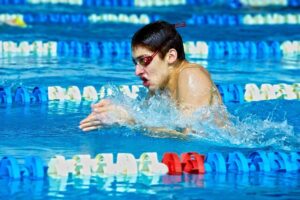
Timing and coordination are crucial in executing efficient arm movements in the breaststroke.
By mastering the pull and recovery phases, you’ll not only generate significant propulsion but also maintain the fluidity and grace that define this swimming style.
Leg Movements and Kicking Technique
The leg movements and kicking technique are fundamental components of the breaststroke, contributing significantly to its distinctive look and propulsion.
The breaststroke kick is often referred to as the “frog kick” due to its similarity to a frog’s leg movement. It consists of two phases: the initial propulsion phase and the recovery phase.
1. Initial Propulsion Phase: As your arms complete the pull phase and are sweeping back towards the streamlined position, initiate the breaststroke kick.
Bend your knees and bring your heels towards your buttocks.
At the same time, turn your feet outward, pointing your toes away from each other.
As your knees are brought together, create a forceful, simultaneous outward push with your feet and legs. This motion generates propulsion, propelling you forward.
2. Recovery Phase: Following the kick’s propulsion phase, it’s essential to execute the recovery phase correctly. Extend your legs and kick them backward while keeping your feet close together.
This outward motion helps minimize resistance as your legs return to the streamlined position. Simultaneously, prepare for the next kick cycle.
Coordinating the arm and leg movements in the breaststroke is crucial for efficiency.
Your arms should be in the pull phase as your legs execute the kick, and vice versa.
The result is a fluid, rhythmic motion that propels you through the water gracefully.
Breathing Techniques
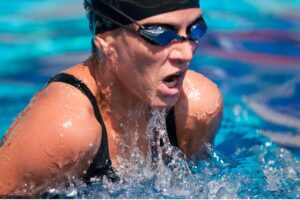
Breathing is a vital aspect of swimming breaststroke, as it allows you to maintain a steady rhythm and provide your body with the necessary oxygen.
The timing of your breaths is crucial in this stroke, and there are specific techniques to ensure you breathe effectively.
1. Breathing Timing: In the breaststroke, you’ll take a breath during the recovery phase of your arm movements.
As your arms are sweeping forward to prepare for the next pull, lift your head out of the water.
Simultaneously, inhale quickly and smoothly through your mouth.
Keep your chin close to the surface, and your mouth should clear the water level just enough to breathe in without lifting your head too high.
2. Exhalation: Exhalation usually occurs when your face is submerged in the water during the pull and kick phases.
As your arms and legs are in motion, exhale steadily through your nose, releasing air while maintaining a streamlined position.
This controlled exhalation helps prevent the need to exhale forcefully when you come up for a breath.
3. Rhythmic Breathing: Developing a consistent and rhythmic breathing pattern is essential. Aim for a breathing cycle that matches the cadence of your stroke.
Typically, swimmers use a pattern of one breath per stroke cycle, but you can adapt this to suit your comfort and fitness level.
4. Practice Breathing Drills: To refine your breathing technique, consider practicing breathing drills.
Focus on the timing and coordination of your breaths while maintaining the proper arm and leg movements.
Over time, you’ll become more proficient at integrating your breaths seamlessly into the breaststroke.
Mastering the breathing techniques in breaststroke not only ensures you have a consistent supply of oxygen but also contributes to the overall fluidity and efficiency of your stroke. With practice, you’ll find yourself gliding smoothly through the water while maintaining a comfortable and effective breathing rhythm.
Common Mistakes and How to Avoid Them
Swimming breaststroke can be a beautiful and effective stroke when executed correctly, but like any swimming technique, it’s susceptible to common mistakes.
Identifying and rectifying these errors is essential to improving your breaststroke.
Here are some frequent missteps and tips on how to avoid them:
1. Lifting the Head Too High: One of the most common errors is lifting the head too high during the breath. This creates unnecessary resistance and disrupts the stroke’s rhythm.
To avoid this, focus on keeping your chin close to the water’s surface when taking a breath. Only lift your head enough to clear your mouth for breathing.
2. Splaying the Arms: Letting your arms drift too far outwards during the pull phase can reduce the stroke’s efficiency.
Ensure that your arms follow a streamlined path, pulling them close to your body to minimize resistance.
Concentrate on the circular sweep motion without excessive lateral movement.
3. Inefficient Leg Kick: An improperly timed or weak leg kick can diminish your forward propulsion.
To improve your kick, work on synchronizing it with your arm movements, ensuring that it follows the pull phase.
Maintain a strong and forceful outward push with your feet to generate power.
4. Breathing Irregularities: Inconsistent or poorly timed breathing can disrupt your stroke’s rhythm and efficiency.
Practice rhythmic breathing by coordinating it with your arm movements, ensuring you breathe during the recovery phase. Maintain a steady pattern to avoid breathlessness or hyperventilation.
5. Over-Kicking: While a powerful kick is essential, excessive kicking can lead to fatigue and decreased efficiency.
Focus on maintaining a balanced kick, generating power without expending unnecessary energy. Efficient leg movements should complement the stroke rather than dominate it.
6. Lack of Streamlining: Failing to maintain a streamlined position throughout the stroke increases resistance and slows you down.
Concentrate on your body’s alignment, keeping it horizontal and streamlined to reduce drag.
This will make your stroke more efficient.
7. Neglecting Core Strength: A strong core is crucial for maintaining body position and balance in breaststroke.
Incorporate core-strengthening exercises into your training routine to enhance your overall technique.
To enhance your breaststroke, video analysis and feedback from a coach or experienced swimmer can be immensely helpful in identifying and correcting these common mistakes.
Consistent practice and mindful attention to technique will gradually lead to a more efficient and elegant breaststroke.
Drills and Exercises for Improvement
Improving your breaststroke technique involves targeted drills and exercises to enhance various aspects of the stroke. Here are some drills and exercises to help you refine your breaststroke:
1. Breaststroke Kick Drills:
• Kick on Your Back: Perform breaststroke kicks while floating on your back to isolate and strengthen your leg kick. Focus on maintaining a steady and powerful kick.
• Kick with a Flutterboard: Hold a flutterboard out in front of you while kicking to improve leg strength and technique. This drill also helps with body positioning.
2. Arm Pull Drills:
• One-Arm Pull: Practice the arm pull motion with one arm at a time while keeping the other arm extended forward. This helps you focus on the pull technique and body position.
• Pull with a Pull Buoy: Place a pull buoy between your legs to isolate your upper body. Concentrate on perfecting the arm pull without using your legs for propulsion.
3. Breathing Drills:
• No-Breath Breaststroke: Swim breaststroke without taking any breaths to improve your lung capacity and adaptability to breath timing.
• 2-Stroke Breathing: Take a breath every two strokes instead of one to practice different breathing rhythms and build comfort with various patterns.
4. Streamlining Exercises:
• Dolphin Kicks: Perform dolphin kicks (similar to the butterfly stroke) while maintaining a streamlined position. This strengthens your core and improves body alignment.
• Streamline Push-Offs: Practice streamlining by pushing off the wall underwater, focusing on keeping your body straight and streamlined.
Work on gliding efficiently before beginning your stroke.
5. Interval Training:
• Incorporate interval training into your workouts to build endurance and refine your stroke technique.
Alternate between fast-paced and slow-paced breaststroke intervals, concentrating on maintaining proper form during both.
6. Dryland Exercises:
• Strengthen your core, shoulders, and legs with dryland exercises such as planks, squats, and resistance band exercises. A strong core is essential for maintaining proper body position in breaststroke.
7. Underwater Pulls:
• Use a resistance band or cord attached to a fixed point to practice underwater pulls.
This exercise strengthens your arm and chest muscles while reinforcing the pull phase of the stroke.
8. Video Analysis:
• Record yourself swimming breaststroke and review the footage to identify areas for improvement.
Compare your technique to videos of skilled swimmers to better understand correct form.
Incorporate these drills and exercises into your regular swim training routine to gradually refine your breaststroke technique. Focusing on specific aspects of the stroke and dedicating time to targeted practice will lead to no
Putting It All Together
Putting all the elements of the breaststroke together is where you’ll truly master this graceful swimming technique.
It involves coordinating your arm movements, leg kicks, breathing, and body position seamlessly for an efficient and elegant stroke.
Here’s how to put it all together:
1. Start with the Glide: Begin your breaststroke by pushing off the wall or starting from a streamlined position.
Your body should be parallel to the water’s surface, with your arms extended forward and legs close together.
2. Pull and Kick Coordination: Initiate the arm pull as your legs start the kick. Your hands sweep outward, and your legs perform a simultaneous outward and then inward kick.
The pull and kick should be synchronized to maximize propulsion.
3. Breathing: As your arms complete the pull phase and start the recovery, lift your head slightly out of the water to take a quick breath.
Inhale smoothly and return your head to the water, maintaining a streamlined position.
4. Arm Recovery: After the breath, continue with the arm recovery by sweeping your hands forward and extending them fully.
Keep your elbows high and close to the water’s surface.
5. Repeat the Cycle: Continue this cycle of pull, kick, breath, and recovery in a continuous, rhythmic motion.
Remember that timing is key; your arms and legs should work together harmoniously.
6. Body Position: Maintain a horizontal body position throughout the stroke.
Focus on minimizing resistance and maximizing forward motion by staying streamlined.
7. Consistent Breathing: Develop a breathing rhythm that suits your comfort and endurance level.
Whether you breathe every stroke cycle or adapt a different pattern, aim for consistency to avoid breathlessness.
8. Efficient Kicking: Make sure your leg kicks are strong and forceful, propelling you forward without excessive splashing. The timing of the kick should complement your arm movements.
9. Turns and Finishes: As you approach the wall for a turn or finish, execute a streamlined glide. Use your arms to push off the wall and continue with the breaststroke cycle.
Practice and Refinement: Consistent practice is essential for refining your breaststroke. Gradually increase your stroke rate while maintaining proper technique to build speed and endurance.
Putting all these elements together in a coordinated and rhythmic manner is essential for a proficient breaststroke. It may take time and patience, but with practice and attention to detail, you’ll develop a smooth, efficient, and elegant breaststroke that allows you to enjoy the water to its fullest.
Advanced Tips for Competitive Swimming
For competitive swimmers looking to excel in the breaststroke, here are some advanced tips and strategies to help you improve your performance:
1. Refine Your Technique: Continuous refinement of your breaststroke technique is paramount. Work with a coach or use video analysis to identify and correct any inefficiencies or flaws in your stroke. Even small adjustments can lead to significant improvements in speed and efficiency.
2. Strength and Conditioning: Incorporate a structured strength and conditioning program into your training regimen. Focus on building strength in your core, upper body, and legs to enhance your stroke’s power and endurance. Dryland exercises and resistance training can be invaluable.
3. Interval Training: Integrate interval training into your workouts to improve your cardiovascular fitness and stamina. Vary the intensity and duration of intervals to simulate race conditions and push your limits.
4. Underwater Dolphin Kicks: Maximize your underwater dolphin kicks off the start and turns.
Work on developing a powerful and streamlined dolphin kick, which can give you a significant advantage during these critical moments in a race.
5. Race Strategy: Develop a race strategy that suits your strengths and fitness level.
Determine the optimal pace for each segment of the race, including the start, turns, and finish.
Practice pacing in training to refine your strategy.
6. Breathing Efficiency: Fine-tune your breathing technique.
Minimize the time spent out of the water during the breath to reduce drag and maintain your stroke’s rhythm.
Focus on keeping your movements smooth and efficient.
7. Turns and Transitions: Pay special attention to your turns and transitions.
Work on executing quick and efficient turns off the walls, utilizing your underwater dolphin kicks to gain momentum.
Smooth transitions between strokes are necessary for maintaining speed.
8. Mental Preparation: Develop mental toughness and race confidence. Visualize successful races and practice positive self-talk.
Embrace pre-race routines that help you stay focused and calm under pressure.
9. Race Experience: Gain valuable race experience by participating in competitions regularly.
Racing against others will help you refine your race strategy, develop race-specific skills, and handle the stress of competition.
10. Video Analysis: Continue using video analysis as a tool for improvement.
Analyze your races and training sessions to identify areas where you can make further improvements.
11. Tapering: In the weeks leading up to important competitions, implement a tapering period in your training plan.
This involves reducing training volume while maintaining intensity to ensure you’re at your peak performance level on race day.
12. Nutrition and Recovery: Pay attention to your nutrition and recovery strategies.
Proper fueling and adequate rest are essential for maintaining optimal performance and reducing the risk of injury.
By incorporating these advanced tips into your training and competition preparation, you can take your breaststroke performance to the next level and compete more effectively at a competitive level.
Post you may like: Is Swimming An Aerobic Exercise?
Conclusion and Next Steps
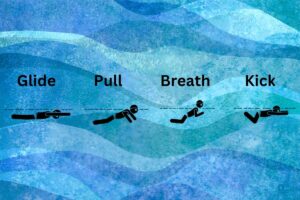
In conclusion, mastering the breaststroke is a journey that offers both enjoyment and challenge in the world of swimming.
From perfecting your body position and streamlining to coordinating your arm and leg movements, this elegant stroke requires patience, practice, and dedication.
As you continue on your swimming journey, remember that improvement is a continuous process.
The next steps on your path to mastering the breaststroke involve consistent practice, refinement of your technique, and ongoing education. Consider these next steps:
1. Practice Regularly: Dedicate time to regular practice sessions to reinforce your breaststroke skills.
Consistency is key to maintaining and improving your technique.
2. Set Goals: Establish clear and achievable goals for your breaststroke performance, whether they relate to fitness, competition, or personal achievement. Goals provide motivation and direction.
3. Seek Feedback: Continue to seek feedback from coaches, experienced swimmers, or video analysis to identify areas for improvement and refine your stroke.
4. Variety in Training: Incorporate a variety of training drills and exercises to challenge different aspects of your breaststroke.
Cross-training and conditioning can also enhance your overall swimming ability.
5. Compete and Gain Experience: Participate in swimming competitions to gain valuable race experience and assess your progress.
Embrace both your successes and setbacks as learning opportunities.
6. Stay Informed: Stay up-to-date with the latest swimming techniques, training methods, and equipment that can enhance your performance.
7. Enjoy the Journey: Above all, enjoy the process of improving your breaststroke.
Find satisfaction in the incremental progress and the sense of accomplishment that comes with mastering this beautiful swimming style.
Swimming breaststroke not only offers physical benefits but also provides a sense of serenity and connection to the water.
Whether you’re gliding gracefully through the pool for leisure or striving for competitive excellence, the breaststroke is a skill that will serve you well in your aquatic adventures.
Embrace the challenge, stay committed, and relish the rewards that come with becoming a proficient breaststroke swimmer.
Post you may be interested in: Is Swimming Bad For Acne?

